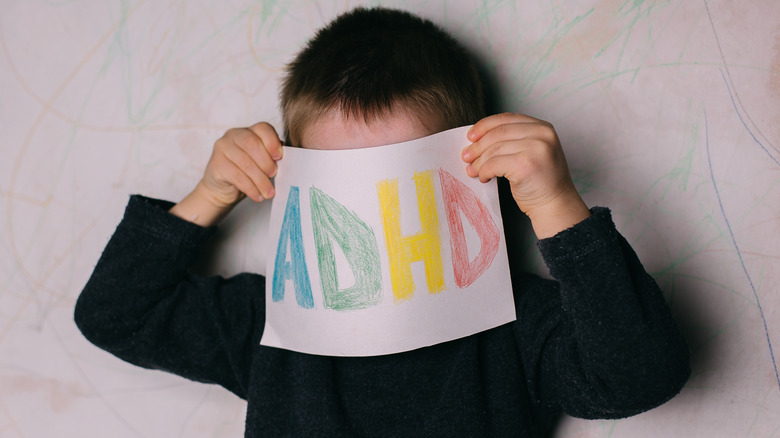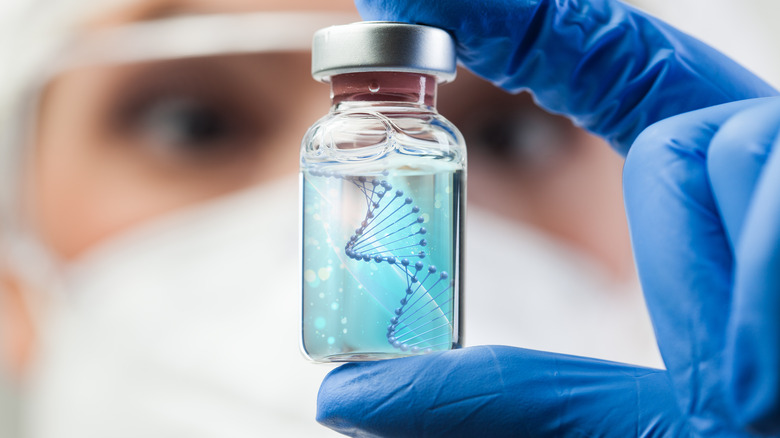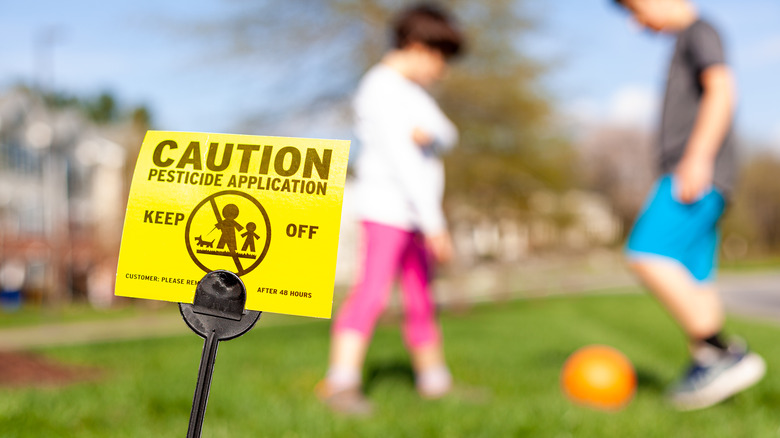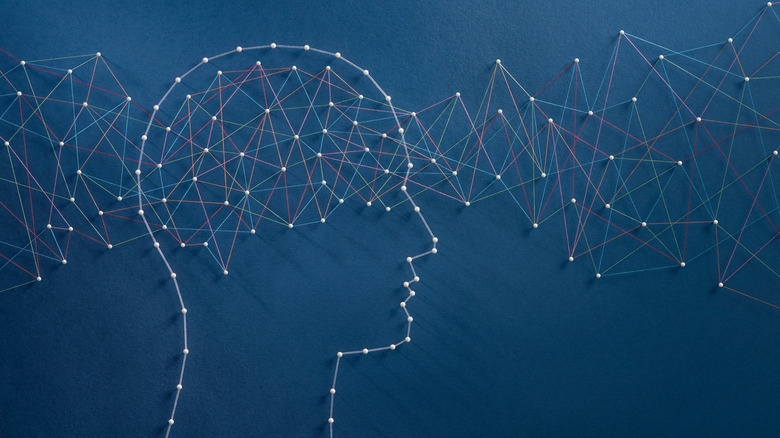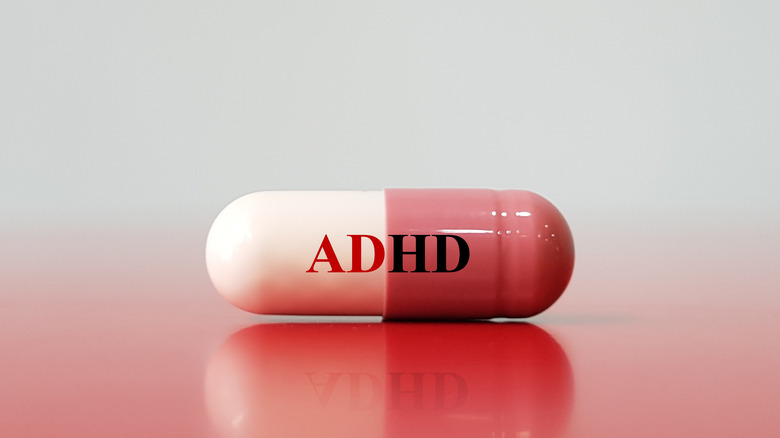ADHD Explained: Causes, Symptoms, And Treatments
ADHD has been known since 1902, when British pediatrician George Still wrote about kids who seemed unable to control their behavior (via US National Library of Medicine). The American Psychological Association (APA) first recognized the disorder in 1968, when it included a description of "hyperkinetic impulse disorder" in the Diagnostic and Statistical Manual of Mental Disorders. In 1980, the name was changed to "Attention Deficit Disorder," or ADD. In 1987 they added "hyperactivity" to get the acronym we know today.
Still, there are people who don't think ADHD is a real disorder. Some believe the symptoms are just normal kid behavior. Some even say it's the result of bad parenting. Much of the controversy seems to stem from the increase in ADHD diagnoses — today, the Stanford Institute for Economic Policy Research says close to one in 10 kids has an ADHD diagnosis, and no one is sure if it's because doctors are getting better at spotting ADHD or if they are overdiagnosing. Either way, few, if any, doctors deny the existence of ADHD. "No scientific meetings mention any controversies," professor of psychiatry Russell Barkley told RealClearScience. "The science is overwhelming that the answer to these questions is in the affirmative: it's a real disorder."
People with ADHD have brain differences
It's easy to deny the existence of something you can't see. For decades, ADHD has been mostly a subjective diagnosis — doctors just figured, if it looks like ADHD, it's probably ADHD (via Psychiatry). Recent studies, though, have confirmed ADHD isn't just something you see in a person's behavior. You can also see it in the brain. A 2006 review published by the European Archives of Psychiatry and Clinical Neuroscience noted that kids with ADHD have a reduction in cerebral volume in the part of the brain responsible for attention, decision making, and impulse control. Kids with ADHD also have volume reductions in the part of the brain responsible for things like working memory, planning, organizing, and paying attention.
According to the Gulf Bend Center, people with ADHD also have a higher concentration of dopamine transporters. Dopamine is a neurotransmitter that controls things like motivation and attention. An excess number of transporters means the dopamine gets moved out of the brain too quickly. Other studies have found that kids with ADHD use different parts of their brains for different tasks than neurotypical children do. So there's plenty of evidence that ADHD brains are different from neurotypical brains.
ADHD is genetic
One thing that has been proven over and over again through decades of research is that ADHD is genetic (via American Journal of Medical Genetics). In fact, many adults have received their own diagnosis after their child is diagnosed with ADHD (via Healthline). Several studies, including one published in 2013 by Cambridge University Press, have confirmed that ADHD has a high heritability rate, which means if you have the disorder you've got a pretty good chance of passing it along to one or more of your kids. The study found that the genetic component of ADHD was about 72%.
According to PsychCentral, the task of identifying the genes responsible for ADHD is difficult because the disorder is so varied and complicated that it's hard to know with any certainty how much of a role any one gene might play. Some studies have, unsurprisingly, found evidence that the dopamine genes DRD4 and DRD5 may play a role. Most, though, have only been able to piece together small sections of the genetic puzzle. Some of the research has also found that the way people respond to ADHD drugs may also have genetic components, so continued research into the genetic component of ADHD may help doctors create more individualized treatment plans.
ADHD may have some environmental causes
ADHD doesn't seem to be 100% genetic, though, so if you're wondering how your neurotypical family managed to produce a kid with ADHD, other factors may have been at work. For instance, there is some evidence that ADHD is associated with exposure to things like pesticides and lead — according to a 2020 review published in the Journal of Attention Disorders, at least 10 studies have found a strong correlation between ADHD and pesticide exposure. A meta-analysis published in the Clinical Psychology Review also concluded that ADHD symptoms were associated with lead exposure. Still, it's hard to say for sure whether these things cause ADHD, exacerbate ADHD, or simply cause symptoms that mimic ADHD.
It's also worth noting that there's a strong correlation between ADHD and prenatal exposure to alcohol or tobacco smoke. A 2015 study in Psychiatry Research found that children whose mothers smoked and drank during pregnancy had a 1.55 times greater risk of developing ADHD. While these outside factors probably aren't enough by themselves to cause ADHD, they may make kids who are genetically predisposed more likely to develop the disorder.
What doesn't cause ADHD
Parents may worry that something they are or aren't doing might increase their child's risk of developing ADHD. Most of the time, though, these concerns aren't justified. While there is some merit to the idea that chemical and lead exposure can trigger ADHD, there isn't any evidence that things like diet or screen time have anything to do with development of the disorder.
A 2012 study by Iowa State University looked at the gaming habits of 3,000 kids and found that the kids who played the most video games had problems with impulsivity and attention. But the Child Mind Institute criticized the study, saying it only proved that heavy gamers were more likely to be kids who already struggled with severe ADHD symptoms. Other things that haven't been found to cause ADHD: sugar (via Journal of Affective Disorders), gluten (Journal of Attention Disorders), or, according to Current Pharmaceutical Biotechnology, anything else in a child's diet. And Everyday Health says that bad parenting — a common scapegoat for ADHD symptoms — also isn't to blame, though it is worth noting that kids with ADHD usually have parents with ADHD, and ADHD symptoms can make parenting especially challenging (via Child Mind Institute).
ADHD causes problems with executive function
An executive, as you know, is the person responsible for making all the important decisions. Similarly, "executive function" is a term used to describe the set of cognitive processes responsible for many important day-to-day activities and life decisions (via WebMD). This includes things like time management, working memory, and planning and organizing. Because their executive function is impaired, people with ADHD can have problems with life skills that come naturally to neurotypical people.
Unsurprisingly, kids who struggle with executive function have problems in school. A 2010 review published by Child: Care, Health and Development noted that a number of studies have identified a strong correlation between poor academic performance and impaired executive function in children with ADHD. But executive function impairment isn't just a problem for kids with ADHD — in 2006 the National Comorbidity Survey Replication found that adults with ADHD suffer a broad range of social problems from marital difficulties to workplace dysfunction and frequent unemployment (via The American Journal of Psychiatry).
Problems with executive function can be hard to treat, especially in adults. According to Psychology Today, ADHD medication is very good at treating things like focus and impulsivity, but not so much things like planning and organization.
ADHD often looks different in girls than it does in boys
Even today, ADHD is grossly underdiagnosed in girls. In fact, according to the Centers for Disease Control and Prevention (CDC), boys are more than twice as likely as girls to be diagnosed with ADHD. But according to a 2015 study published in the American Journal of Psychiatry, the numbers of adults with ADHD are evenly split between men and women, which suggests that a lot of girls just aren't getting diagnosed.
ADHD is often overlooked in girls because they can present different symptoms. According to a 2014 review by the Primary Care Companion for CNS Disorders, girls are often considered "subthreshold," which means they don't usually have the obvious symptoms that set off alarms with teachers and parents. Girls tend to display more inattentiveness than hyperactivity or impulsivity, so their symptoms can be more easily overlooked. They are also more likely to develop coping strategies, which means they don't always perform poorly in school the way boys with ADHD often do. Girls may also have symptoms like anxiety and depression, which are not ADHD symptoms but are common comorbidities. Because of this, they may be diagnosed with other disorders, and doctors may not even suspect ADHD.
There is more than one form of ADHD
Most people think of ADHD as hyperactivity. The word is right there in the name, after all. But ADHD actually has three forms, and one of them doesn't include hyperactivity at all. According to the CDC, predominantly hyperactive-impulsive ADHD is the classic form of the disorder. Children with this form are often described as "driven by a motor." These kids have a hard time controlling their behavior or staying still. This form of ADHD is pretty hard to overlook.
The second form of the disorder is predominantly inattentive ADHD. In this type, hyperactivity is limited or absent. Predominantly inattentive ADHD wasn't described until 2000, when it was added to the APA's Diagnostic and Statistical Manual of Mental Disorders (via Journal of Attention Disorders). Because the subtype hasn't been known as long, it's still frequently overlooked — even though a 2010 paper from the Journal of the American Academy of Child & Adolescent Psychiatry noted that it's now the most prevalent lifetime diagnosis of the disorder.
The third subtype identified by the APA is the combined subtype. People with this subtype have both hyperactivity and impulsivity, as well as problems with attention.
ADHD does not usually go away during adulthood
There is a persistent myth that ADHD just goes away on its own once a person reaches adulthood. For a few people, that does seem to be true. However, data published in March 2021 by the ADHD Institute made an effort to correct the notion that this happens in most cases — according to its worldwide review, about 50 to 65 percent of kids with ADHD become adults with ADHD. But not everyone agrees that those are even the right numbers. A 2021 study published in the American Journal of Psychiatry found that only 10% of 588 kids with ADHD followed over a 16 year period "outgrew" the disorder when they reached adulthood. Researchers attributed that 50% number to the fact that most studies tended to only check in with participants one time when they were adults, and ADHD symptoms in adulthood often "wax and wane" over time as stressors and environments change. ADHD may also look different in adults than it does in children. According to the Cleveland Clinic, hyperactivity in adults may manifest as restlessness, and impulsivity may appear in the form of impulse buying and other irresponsible behavior.
Diagnostic criteria for ADHD
Despite the high prevalence of the disorder and the fact that it's being diagnosed in more people than ever before, it can still be difficult to get an ADHD diagnosis. Diagnostic criteria is pretty strict, and most clinicians won't prescribe ADHD medication unless a patient meets all the criteria. According to the CDC, in kids, patients need to have six symptoms of inattention and six symptoms of hyperactivity and impulsivity in order to meet the criteria for an ADHD diagnosis. Additionally, at least some of those symptoms need to have been present before age 12, and the child's symptoms must be present in two or more settings (such as home and school). There also needs to be evidence that the symptoms interfere with normal functioning, and that they can't be explained by another disorder.
Adults face additional hurdles. According to the Recovery Village, even adults with clear symptoms of debilitating ADHD can't claim disability benefits unless they were diagnosed with ADHD as children. That means kids who were overlooked or did not seek treatment — and are therefore more likely to have ongoing problems as adults — are the least likely to get help when they need it.
How ADHD is diagnosed
The criteria for diagnosing ADHD seems pretty straightforward, but still, it's a really subjective process. You can't diagnose ADHD with a single test (via CHADD). Instead, clinicians have to do some sleuthing. They look at information about a child's behavior at school and at home, and compare it to that of other kids of the same age. If that seems problematic to you, that's because it is. In fact, according to a 2005 paper published in Psychiatry, the subjective nature of the diagnosis may be leading to overdiagnosis of ADHD. The doctor who determines whether or not a child has ADHD doesn't usually observe any of the symptoms firsthand — they have to rely on what parents and teachers have to say about a child's behavior. And because kids with ADHD are eligible for more academic support, there can be an incentive to obtain an ADHD diagnosis even when a child's problems may stem from elsewhere.
Doctors may soon get help with ADHD diagnoses
The way ADHD is diagnosed may be changing. According to U.S. Pharmacist, the FDA recently approved a device called The Neuropsychiatric Electroencephalograph-Based ADHD Assessment Aid (NEBA), a tool that measures theta and beta brainwaves. Because the theta/beta ratio is higher in kids with ADHD, it is a more objective way to arrive at a diagnosis. The results from the device aren't meant to be the only thing a doctor considers, but an objective measure does provide the kind of information that could help prevent an inaccurate diagnoses. The device does seem to be helpful in identifying kids who may have a different condition — according to a 2018 study in Brain and Behavior, it was able to identify 91% of a cohort that a group physicians had concluded probably did not have ADHD.
If the device continues to prove helpful, it could be a major breakthrough in the way we diagnose and treat kids with executive function disorders. Identifying kids who have symptoms but do not have ADHD will not only reduce the number of erroneous diagnoses and present a more accurate picture of the prevalence of ADHD, it will also help misdiagnosed children get the right kind of treatment.
There may be such a thing as adult onset ADHD
ADHD has long been thought of as a childhood disorder, and the idea that kids will just "grow out of it" almost certainly contributed to the myth that adults can't have ADHD (via ADHD Awareness). But not only has the research shown that most people don't outgrow their symptoms (via ADHD Institute), it's also starting to reveal that adult onset ADHD might actually be a thing.
Despite diagnostic criteria that at least some symptoms have to be present before age 12 (per the CDC), there is some evidence that childhood ADHD may not be a prerequisite for adult ADHD. A four decades-long study published by The American Journal of Psychiatry, in fact, found that adults with ADHD don't always have a history of childhood ADHD. And it's not just a few adults, either — the study found that a whopping 90% of people with adult ADHD had no history of the disorder as children. It is important to note that the authors weren't able to say for sure that the adults in the study had ADHD rather than another disorder with similar symptoms. And there is also the possibility that many of them did have ADHD as kids, but failed to accurately recall their symptoms.
Medication can be helpful for ADHD patients
One of the standard methods for treating ADHD is medication (via Mayo Clinic). Still, a lot of parents are reluctant to give medications to their children because of concerns about long-term health implications, or even a worry that medication will "change" their child's personality. According to the CDC, medication can be helpful for kids age 6 and up. The reason the American Academy of Pediatrics can make this recommendation with such confidence is that the medicines commonly used to treat ADHD have been prescribed for more than half a century and have been shown to be very safe for long-term use. According to Harvard Health, there is no evidence that Ritalin (methylphenidate), the most commonly prescribed drug used to treat the disorder in children, is associated with any life-threatening side effects. The worst reported side effects tend to be trouble sleeping and decreased appetite.
Adderall (amphetamine and dextroamphetamine) is another drug frequently prescribed for ADHD (via Healthline). Like Ritalin, Adderall is a stimulant. Both medications work by upping the number of neurotransmitters like dopamine that are available in the brain. There are also non-stimulant medications available like Strattera (atomoxetine), but these tend to be less effective.
Behavior therapy may also help manage ADHD symptoms
Besides medication, clinicians usually recommend some form of behavior therapy to help patients manage ADHD symptoms (per CDC). For children, this includes support both for kids and for their parents. According to the CDC, a good behavioral therapy program teaches kids how to strengthen positive behaviors and eliminate or reduce behaviors that can be disruptive or counterproductive. Meanwhile, parents learn strategies for supporting their children and helping them deal with some of their most challenging symptoms. It's worth noting that the American Academy of Pediatrics doesn't recommend behavior therapy alone, but suggests combining it with medication in order to maximize its benefits.
For adults, cognitive behavioral therapy (CBT) has been shown to be helpful in managing ADHD symptoms. According to CHADD, this type of therapy focuses on the present instead of looking into the past. There are forms of CBT that have been developed specifically for adults with ADHD, so people who don't feel like their disorder is well-managed on medication alone may be able to find help with a CBT therapist. Again, it's a good idea to combine CBT with medication rather than trying to manage symptoms with CBT alone.

